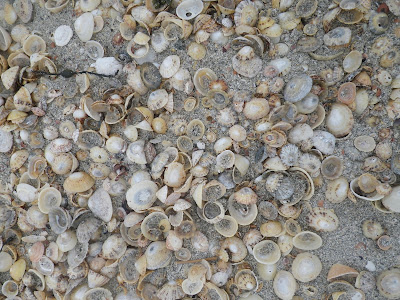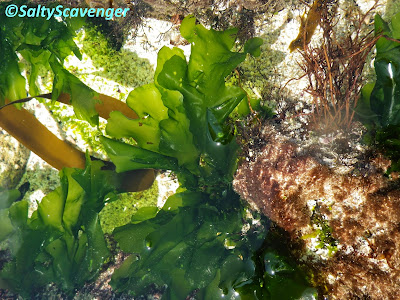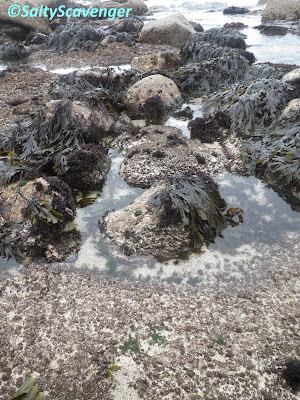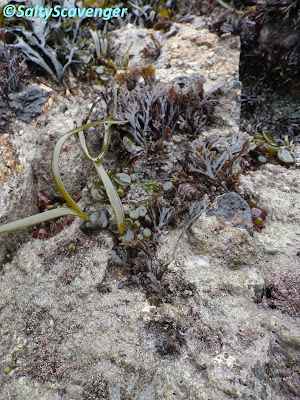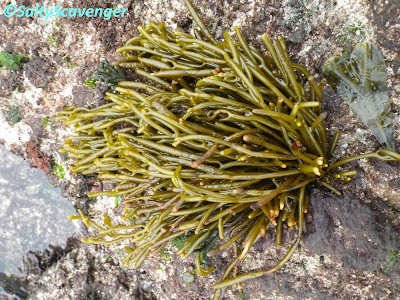The shore comprises a sandy bay flanked by outcropping bedrock and cliffs.
The exposed shore is characterised by an extended lichen zone that reaches up the cliffs to form distinct bands of yellow and grey lichens and below the black, tar lichen. Periwinkles occur across the shore and barnacle communities dominate scour free rocks of the mid and lower shore, whilst sand scoured rocks are barren or, support organisms within the rock crevices.
Habitat classification:
Substrate
|
LR (Littoral rock)
|
LS (Littoral substrate)
|
Habitat
|
LR.HLR (High energy littoral rock)
|
FLR (Features of littoral rock)
|
LS.LSa (Littoral sand)
|
Biotope complex
|
LR.HLR. MusB (Mussel and/or barnacle
communities)
|
LR.HLR.FR (Robust fucoid and/or red
seaweed communities)
|
LR.FLR.Lic (Lichens on supralittoral
rock)
|
|
Biotope
|
|
|
LR.FLR.Lic.Ver (Verrucaria maura
on littoral fringe rock)
|
LR.FLR.Lic.YG (Yellow and grey
lichens on supralittoral rock)
|
|
Below are images of organisms you may encounter whilst rockpooling within these habitats:
 |
| The shore comprises sand flanked by bedrock outcrops and cliff. Habitat classification: LS.LSa (Littoral sand) EUNIS A2.2 and LR.HLR (High energy littoral rock) EUNIS A1.1. |
 |
High wave exposure leads to an extended splash zone enabling lichens to colonise further up the cliffs. Two distinct bands of differing lichen communities can be seen. At the highest position on the supralittoral are yellow and grey lichens, whilst on the littoral fringe below black tar lichen (Verrucaria maura) covers the bedrock. Habitat classification: LR.FLR.Lic.YG (Yellow and grey lichens on supralittoral rock) EUNIS: B3111 and LR.FLR.Lic.Ver (Verrucaria maura on littoral fringe rock) EUNIS: B3.113.
|
 |
Rough periwinkles (Littorina spp) are the dominant motile species of the Verrucaria maura biotope.
|
 |
| Littorina spp |
 |
| Littorina spp |
 |
| Littorina spp |
 |
| A turf forming Rhodophyta |
 |
| Sand scour tolerant ephemeral green and red seaweeds occur sporadically at the rock bases. |
 |
| Small periwinkle (Melarhaphe neritoides) |
 |
| Rough periwinkles (Littorina spp) and Small periwinkles (Melarhaphe neritoides) |
 |
| Patella vulgata |
 |
| Patella vulgata huddle in the leeward corner of the rock. |
 |
| Barnacles occur at low abundance on the upper shore. |
 |
| Barnacles and Small periwinkles (Melarhaphe neritoides). |
 |
| Barnacles |
 |
| Barnacle abundance increases on the mid and lower shore. Note that on these sand surrounded boulders, sand scour prevents further downward colonisation of barnacles. Habitat classification: LR.HLR. MusB (Mussel and/or barnacle communities) EUNIS A1.11. |
 |
| Barnacles of the mid shore. |
 |
| Common blue mussels (Mytilus edulis) occur within rock crevices. |
 |
| The rough periwinkle, Littorina compressa var. nigrolineata occurs amongst the barnacles of the mid and lower shore. |
 |
| Barnacles and M. neritoides |
 |
| Else where sand scour is too prolific to enable sessile organism to grow. |
 |
| In such conditions, organisms are restricted to the crevices. |
 |
| M. edulis and robust fucoids grow within boulder crevices. |
 |
| Barnacles, P. vulgata and M. edulis. |
 |
| M. edulis |
 |
| Serrated wrack (Fucus serratus) and red seaweeds grow from crevices of the lower shore boulders. Habitat classification: LR.HLR.FR (Robust fucoid and/or red seaweed communities) EUNIS: A1.12. |
 |
| F. serratus |
 |
| Below the F. serratus understory are a variety of robust red seaweeds. |
 |
| Mastrocarpus stellatus and F. serratus |
 |
| A boulder of the lower shore has become covered by sand, to reveal just the tops of the F. serratus. |

